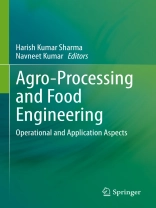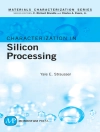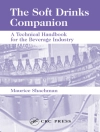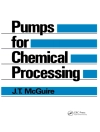This textbook highlights the engineering fundamentals and processing aspects of agricultural produce and covers important aspects of agro-processing and food engineering in one place. The chapters cover material handling, drying, size reduction process, mixing and forming, cleaning and separation, storage, and processing of cereals, pulses, oilseeds, fruit and vegetables, and their products. The book’s contents are systematically designed to provide a balanced overview of agro-processing techniques from the basic concepts to the case study, handling of the materials, and different unit operations. The systematic and simple elaboration of scientific aspects will make it unique and help to develop skills in the field. Many illustrations in form of diagrams/charts/pictures provide a clear understanding. Solved numerical problems, which are given in the chapters, will provide students clarity in conceptualizing the basics. The book covers the syllabus related to agro-processing and foodengineering at the undergraduate and postgraduate level in various universities, agricultural universities, allied institutes, and colleges across the globe. It will be extremely beneficial to students as it covers the most important and relevant topics, which are hardly covered in any other single compilation and published textbooks. It would be a good textbook for universities, agricultural universities, institutes, and colleges running courses in agriculture, horticulture, postharvest technology, process and food engineering, food engineering, food engineering and technology, food technology, food science, and food and nutrition.
Inhaltsverzeichnis
Chapter 1. Agro Processing: Scopeand Importance.- Chapter 2. Engineering Properties of Foods.- Chapter 3. Material Handling and Transportation Devices.- Chapter 4. Design of Material Handling Systems.- Chapter 5. Drying.- Chapter 6. Size Reduction.- Chapter 7. Mixing and Forming.- Chapter 8. Cleaning and Separation.- Chapter 9. Storage.- Chapter 10. Processing of Cereals.- Chapter 11. Processing of Pulses.- Chapter 12. Processing of Oilseeds.- Chapter 13. Processing of Fruits and Vegetables.-
Über den Autor
Dr. Harish Kumar Sharma is a Professor at Sant Longowal Institute of Engineering & Technology (SLIET) (Deemed University) and is currently working as Director of NIT Agartala, and is founder Mentor Director of IIIT Agartala. Dr. Sharma is involved in teaching Postgraduate students and has supervised 16 Ph.D. and 37 M.Tech. students. He has published 193 papers in national/international journals/proceedings in Food Engineering/Technology, authored/edited eight books, two proceedings, and two manuals published by reputed national and international publishing houses. He has contributed 23 chapters in books published by national and international publishing houses and visited different countries. Dr. Sharma has successfully handled several projects and successfully transferred a technology on a commercial scale. He has filed two patents and possesses two copyrights and rendered technical assistance to different industries.
Dr. Navneet Kumar
is an Associate Professor and Head of the Department of Processing and Food Engineering at the College of Agricultural Engineering and Technology, Anand Agricultural University, Godhra, Gujarat, India. He is involved in teaching undergraduate and postgraduate students and has taught more than ten food-process engineering subjects so far. He has guided several master’s students as a supervisor and doctoral students as a member of the advisory committees. Dr. Kumar has contributed more than 50 publications as research papers, review papers, books, and book chapters. He has been awarded Fellow of Institution of Engineers (FIE), Distinguished Service Certificate (ISAE), and best research paper award in the field of food engineering (AFSTI). He also has delivered lectures/talks on different aspects of food processing at various Institutes across India. He is currently working in drying, dehydration, mathematical modeling, storage stability, traditional foods, and minimal processing.












